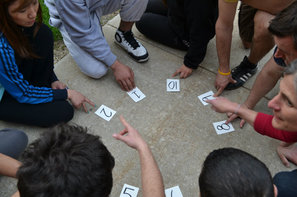
Get out your set of number cards (or numbered poly spots, ear tags, or foam numerals) and, starting with the number 1 give everyone a number in sequence. Circle up in sequential order and have your players set their numbers in front of them (see picture) so that, in the end, the highest number in the sequence is next to the number 1 (i.e., end up with a circle of numbers in numerical order).
Here's the challenge. Tell your group that you have a number of secret codes for them to break (maybe before they can access their next challenge). Each code is a pattern of numbers that has a logical formula - they are not simply a random order of numbers. For instance, (using the set of numbers in the picture, 1 to 10), touch the numbers in numerical order from 1 to 10 (I always use this as an example with my groups). When the group decides on the pattern and announces it they must carry out the action stated - each player touching his or her number in the pattern stated. You can then announce weather or not they have broken the code (maybe a sound effect?). (Note: In my experience groups have successfully broken another one of the codes during an attempt at an "easier" level. I do not reveal this fact, I simple fail the attempt. More often than not groups will then believe that what they tried is not longer valid and will not attempt the pattern again later in the activity. We then get to talk about how some solutions are about timing - when is it the right time to offer a particular solution?)
I have come up with a list of five secret codes that I believe to be sets of less to more complex numbered sequences - at least this is what I tell my groups (to get the point across this list has worked well for me so far). When a group breaks the first code they move on to the next code and so on. I also set a time limit for the challenge (e.g., 20 minutes) in order to have the option to move on to other activities (this one can get pretty intense). If we run out of time I always share the answer to the code they were working on and then move into talking about their experience.
Secret Codes:
(For this example, say we are working with 10 numbers):
- Touch the numbers in order from 1 to 10 (I like using this one first because I already mentioned this sequence as the example - some groups don't believe it would be a sequence since I said it. A "teachers" help is often overlooked in order to find ones own answers.)
- Touch the numbers in reverse order from 10 to 1.
- Touch all the odd numbers first, in order, then all the even numbers, in order.
- Touch all the even numbers first in descending order (10 to 2), then the odds, from 9 to 1.
- Touch all the numbers in alphabetical order by the spelling of the number.
Again, my (main) facilitated objective for this activity is for the group to go through a process of brainstorming, choosing, trying, and evaluating ideas. And, of course, all the wonderful dynamics there in. Using this activity with the right group brings up lots of great things to discuss.
Other logical sequences? Let me know how it goes for you. Leave a comment for us.
All the best,
Chris Cavert






 RSS Feed
RSS Feed